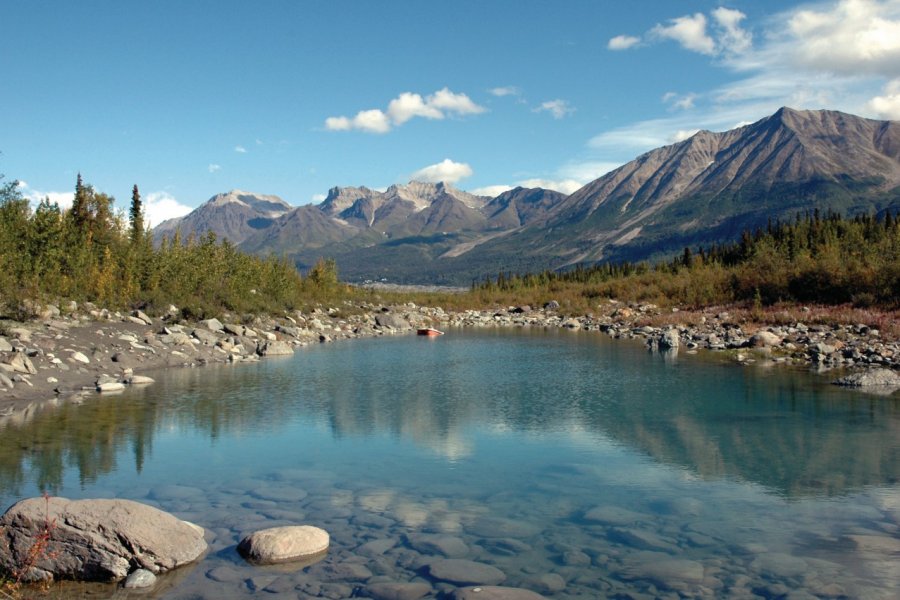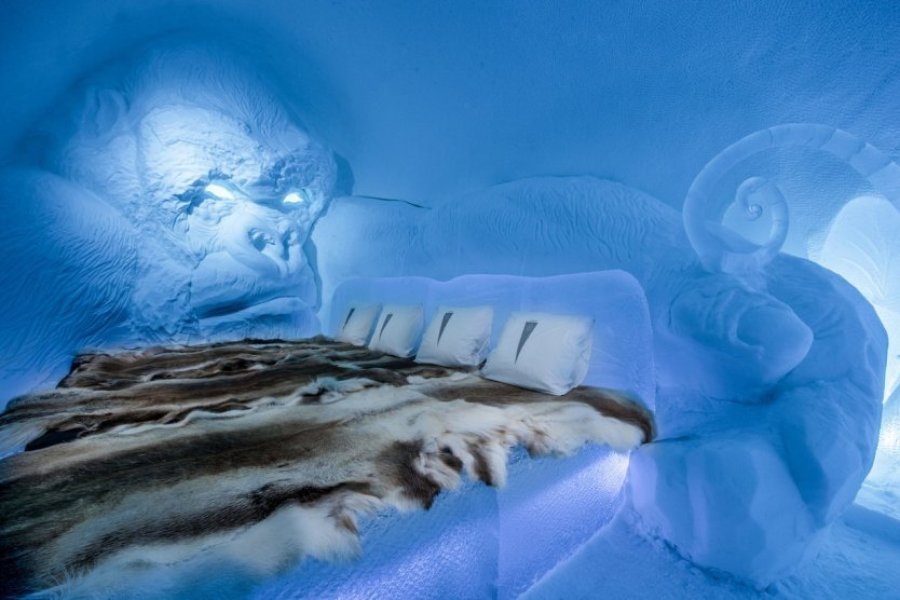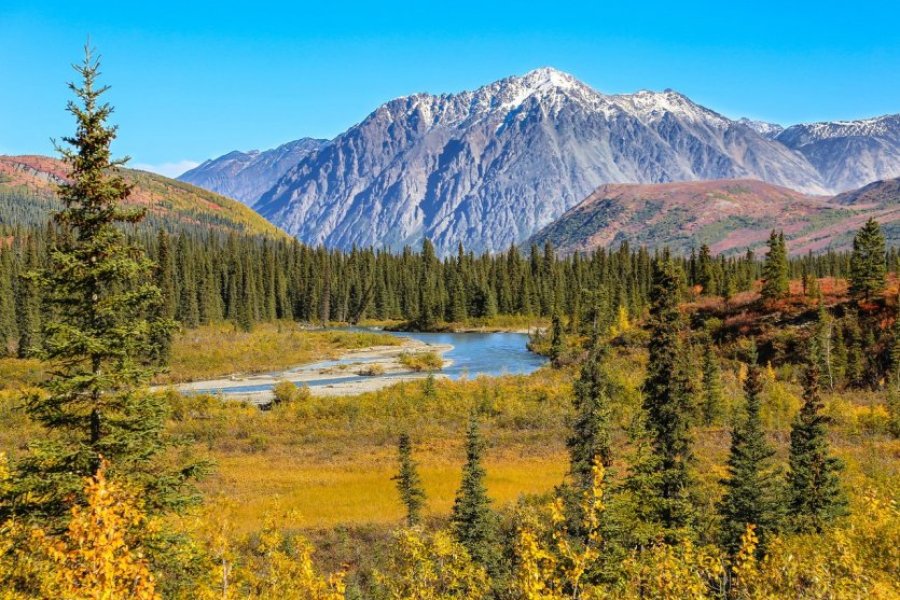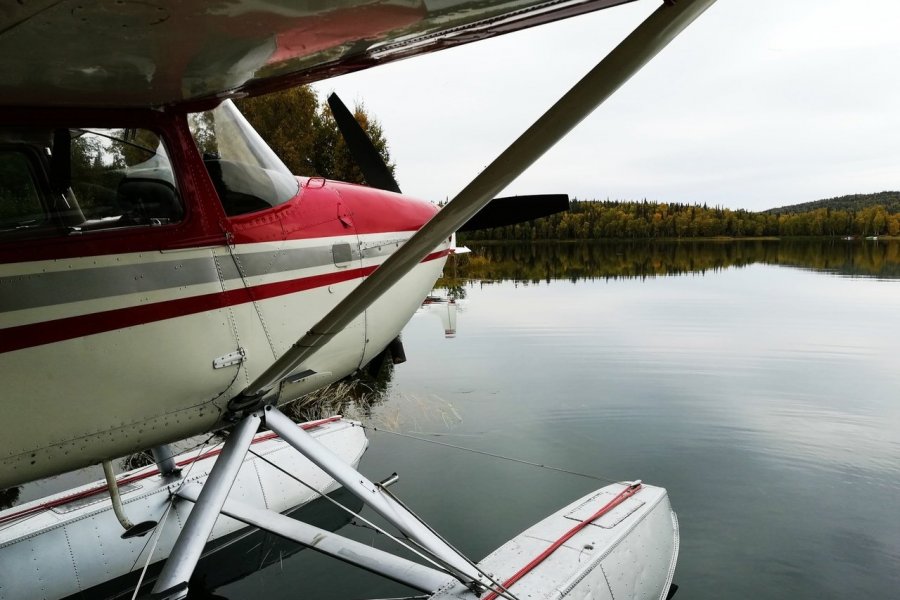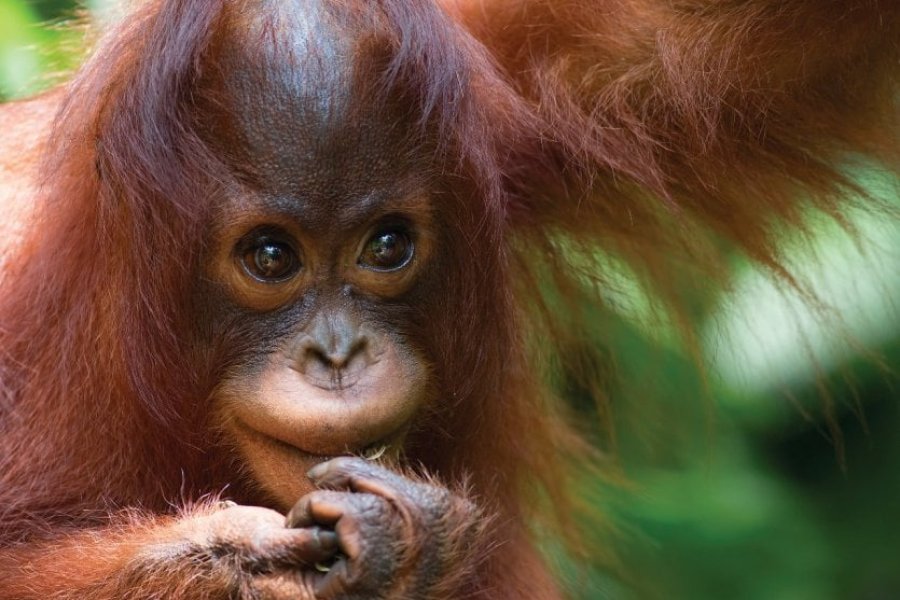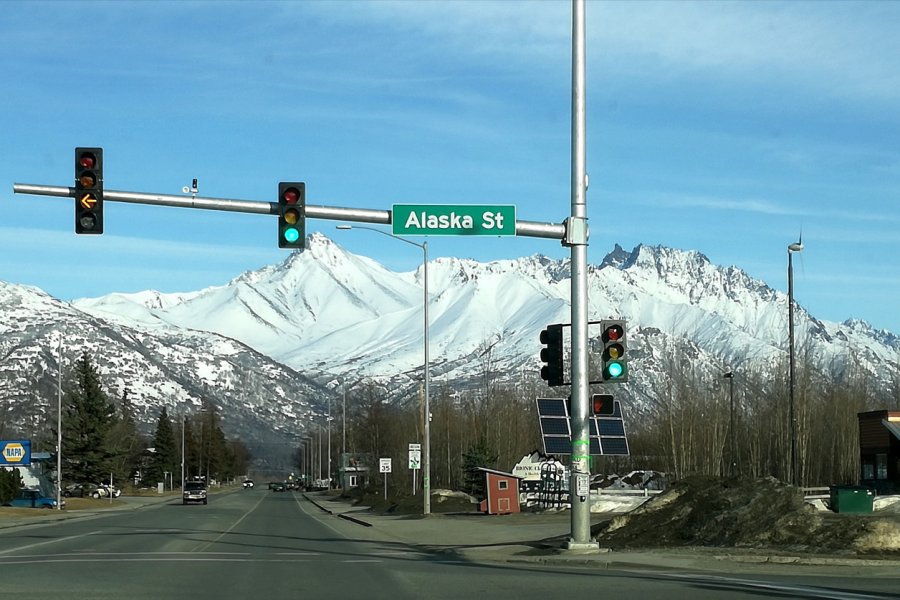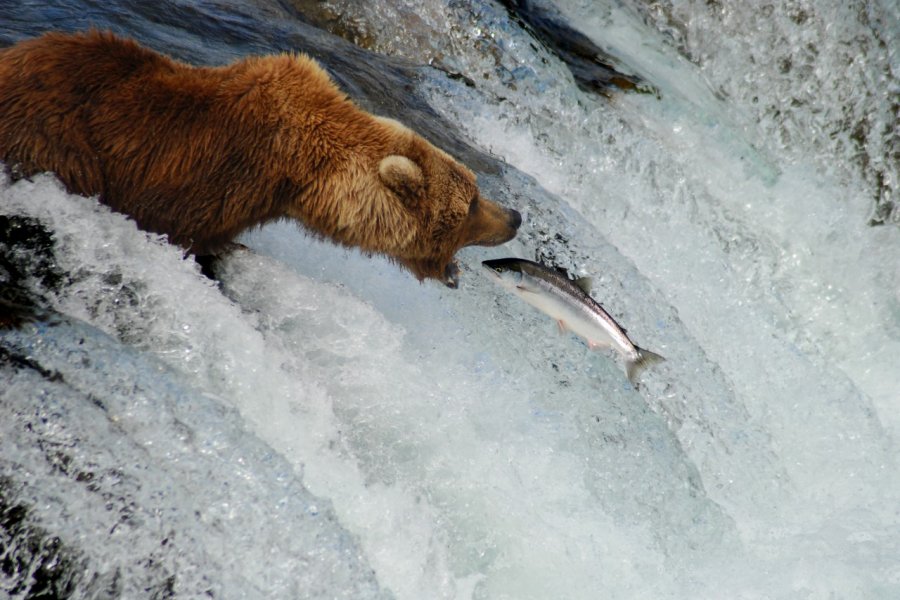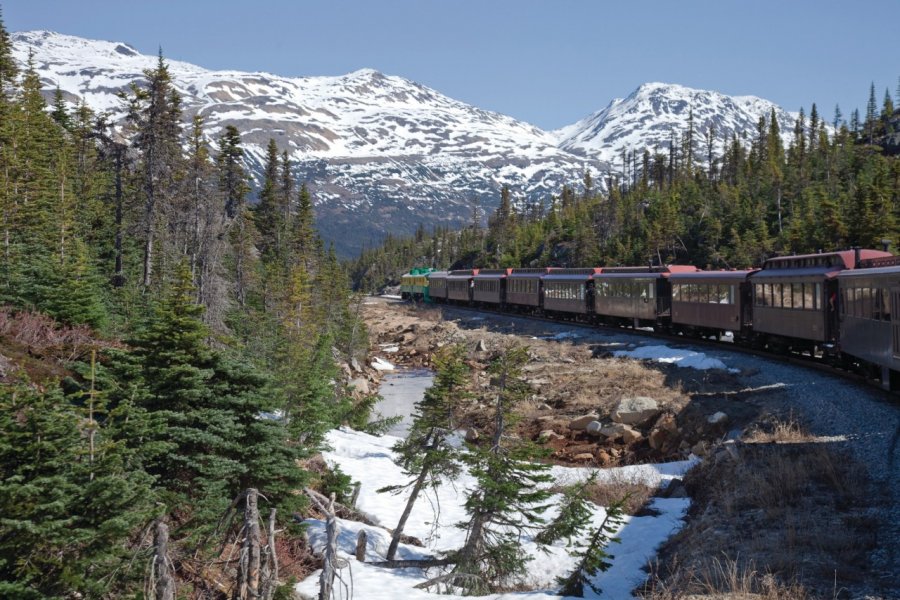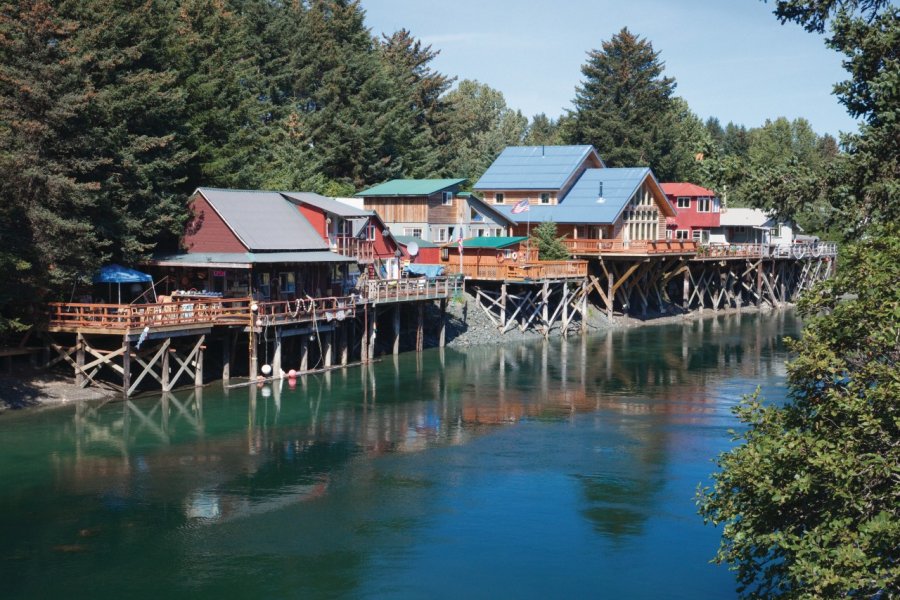Travel guide Alaska
The Last Frontier, wild and hostile, is what we call the ultimate territory seized during the great conquest of the West. A gigantic state in the United States from the Far North bordering the Arctic Ocean to the north and Pacific, Alaska is a land where nature reigns supreme. Those who live there consider themselves much more Alaskan than Americans: they have developed a way of life made up of multiple traditions to adapt to the climate, the certainty that after the harsh polar winters always follow a resplendent explosion of colours and life. The Alaskan tourist guide offers orientation trails in the heart of this pristine and majestic part of the world. Anchorage is to the south, from where roads lead to Valdez or to the Kenai Peninsula with its fishing ports, with the Alaska Peninsula and Katmai Park, the brown bear sanctuary, off the bay. In the centre, the 6,190 m of Mount Denali gushes out, watching Fairbanks and its trapper cabins. As you cross the Arctic Circle, you can see incredible Northern Lights and whales, seals and polar bears evolve. On Nome Beach, we think back to the first American tribes crossing the Bering Strait, then to the adventurous gold panners, while to the southeast, Orthodox sacred architecture takes us back to the distant Russian past. Finally, in Juneau, the sublime fjords lead the way to the heart of the Passage Intérieur.... Alaska is a treasure chest, whose nature has the keys.
What to see, what to do Alaska?
-
Book an activity
-
Customized travel
- The most beautiful cities Alaska
When to go Alaska ?
When to go to Alaska? The few who love extreme conditions will certainly appreciate the winter season, when the snow spreads as far as the eye can see and in abundance on the Alaskan reliefs: it's time to go skiing, skating on frozen lakes, snowshoeing or snowmobile and dog sledding races. But also to observe the Northern Lights! As temperatures can drop to -35°C in January in Fairbanks, the best time to travel to Alaska without having to deal with harsh weather is between the end of May and the end of September, with summer concentrated in July and August. In this interval, the weather is relatively mild (between 10 and 20°C in July) even though it is important to know that rain, snow and cold can still occur depending on the location. Some places or activities are not accessible before the end of June because of the snow and ice always present. During the good season, it is the opportunity to practice camping, hiking or water sports in total immersion in this wild and grandiose nature. Finally, before leaving to discover the "last frontier", you should take care to bring warm but light clothes, enough to beat the rain and the wind. So when to go to Alaska? During the high tourist season, from May to September, taking care to book your accommodation well in advance.
Suggested addresses Alaska
Travel Alaska
-
Find a hotel
-
Car Rental
-
International e-SIM package
-
Find a local agency
Find unique Stay Offers with our Partners
How to go Alaska
How to go alone
The price of a flight from France ranges from 700 € for the lowest prices and up to 2 000 €. In the summer, some companies offer direct flights from Europe to the North Pole. Otherwise, you will have to make one or two stopovers in another U.S. city. As for accommodation and activities, organizing your trip well in advance will save you money. Campgrounds and hostels are cheap options.
How to go on a tour
Organizing a trip to Alaska is not an easy task, so using the services of specialized agencies can be a solution, which certainly has a cost (a stay in Alaska is expensive, and you will have to put your hand in your pocket to ensure unforgettable experiences!), but which will greatly facilitate your steps. Thematic tours vary enormously, and it is possible to concoct a customized trip with the agency that best suits you.
How to get around
Alaska's skies are among the busiest in the world, due to its vast territory. Many trips are made bybushplane, and even if the races have a price, it will be easy to find seats. On the sea side, the state-owned company covers all possible connections, while a train (picturesque, but slow and expensive) connects Anchorage to Fairbanks (north) and to the Kenai Peninsula (south). A car provides greater freedom.
Featured articles Alaska
Discover Alaska
The 49th state of the USA is a vastness to explore. We can fly over its geography to begin with and discover its very particular history, between Russian colonization, gold rush and discovery of oil. Its destiny is torn between protecting the environment, threatened by global warming, and exploiting its natural resources. Visiting the area for tourists is often synonymous with discovering its wildlife, especially the bears that we come here to see fishing the salmon wriggling up the rivers. Its marine wildlife is also a magnificent sight: whales, orcas, sea lions swim in its icy waters in summer. Under its very American way of life and its very present religion, hides a population of "natives" with customs highly linked to the extreme environment of Alaska and to ancestral beliefs. A surprising land.
Pictures and images Alaska
The 12 keywords Alaska
1. Alaska Native
The Alaska Natives, consisting of the Yup'ik, Cup'ik and Inupiak peoples, subdivided into many others, prefer the name Alaska Native or Inuit to Eskimos. A pejorative term tolerated by the Yu'piks but rejected by the Inupiaks, yet widely used by the Americans to qualify the indigenous peoples of the Arctic.
2. Aurora Borealis

Red, green, blue... these draperies of the sky illuminate the polar night from September to March. For the Tlingit Indians it is the sign of the welcome to the sky of a fallen warrior. For scientists, the electrons and protons projected by the solar wind at the poles collide with the helium and hydrogen in the atmosphere, releasing photons
3. Bush pilot
These pilots, true local heroes, maneuver the famous bush planes, these micro planes of the past that still fly in the Alaskan sky. Among them, the iconic floating planes, land on water or on skis! They serve the most isolated corners, to supply villages or for the pleasure of tourists.
4. Denali
This word means in Athabascan language "the one who is high". And for good reason, Mount Denali, renamed from its original name by Barack Obama in 2015, is the highest peak on the North American continent (6,193 meters). The eponymous national park is the most visited in Alaska, renowned for its hiking and its wonderful landscapes of bear-populated forests
5. Glaciers
100 000... This is the approximate number of glaciers identified in Alaska. They represent more than half of the known glaciers of the planet. The largest of them covers the surface of Switzerland! Here the retreat of glaciers due to global warming takes all its meaning: their underwater melting is 100 times faster than expected...
6. Iditarod
Temperatures hovering around -40°C, blizzards, snowstorms, and men alone with only their dogs for companions, traveling 1,800 km on their sleds through the Alaskan wilderness. This is the toughest annual dog sled race, comparable to single-handed sailing races
7. Mountain
Mountain ranges and their eternal snows are omnipresent in Alaska. Indeed, the state gathers 17 of the highest peaks in North America, including Mount Denali, the highest point of the continent. These mountains will delight hiking, mountain biking, mountaineering and winter sports enthusiasts, including skiing at Alyeska Resort in Gridwood.
8. Moose
Moose are emblematic of Alaska, where there are over 150,000 of them. You will inevitably come across them during your stay, at the bend in a walk or on the side of the road. This massive herbivore can reach 700 kg. They are unfortunately responsible for more than 800 car accidents per year in this state alone.
9. Snow
From north to south, from east to west, in winter, the snow scatters its long immaculate coat for a large part of the year. It covers everything from October to April, with heights reaching 4 m in places. In summer, it is not uncommon to see snow here and there, not to mention the eternal snow that shimmers on Alaska's highest peaks
10. Bear
The black bear, the grizzly bear and the polar bear are the three species present in Alaska. There are nearly 100,000 black bears and 35,000 brown or grizzly bears (which can weigh up to 800 kg), while the world's polar bear population - all countries combined - is barely 20,000, because it is threatened with extinction by global warming.
11. Salmon

There are five different species of Pacific salmon, the most famous of which is the King Salmon. Their fishing, both commercial and recreational, generates considerable economic benefits in Alaska. Bears are the biggest fans of this fish that leaves the ocean floor to go up the rivers and reproduce each summer
12. The Last Frontier
During the conquest of the West, the line separating the conquered territories from the wilderness, which still belonged to the Native Americans, was called the frontier. Once the region was unified and colonized in 1890, Alaska appeared as "the last frontier", a land not yet mapped in all its details that keeps its mystery.
You are from here, if...
You always walk with a bell, a bear spray and making a lot of noise to signal your presence to the plantigrades. This is far from a silent walk in communion with nature!
You watch your gas level permanently, because on the roads gas stations are rare. You are also vigilant not to be surprised by an elk that can appear on the road at any time
You have several pairs of snow shoes in your garage (crampons for the snow), keeping company with alpine skis, touring skis, cross-country skis... the whole set!
You know how to handle a dog sled. In Alaska, mushing is a national sport that is practiced from childhood
You show unfailing solidarity when you see someone in trouble. Mutual aid and solidarity are unshakeable values in Alaskan society, which lives in harsh and extreme conditions where mistakes are not forgiven.
Other destinations Alaska
- Wrangell-St Elias National Park
- Denali National Park
- Glacier Bay National Park
- Fairbanks
- Cooper Landing
- Skagway
- Lake Clark National Park
- Katmai National Park
- Anchorage
- Valdez
- Homer
- Gates Of The Arctic National Park
- Juneau
- Kenai Fjords National Park
- Seward
- Kobuk Valley National Park
- Soldotna
- Moose Pass
- Nome
- Ninilchik
